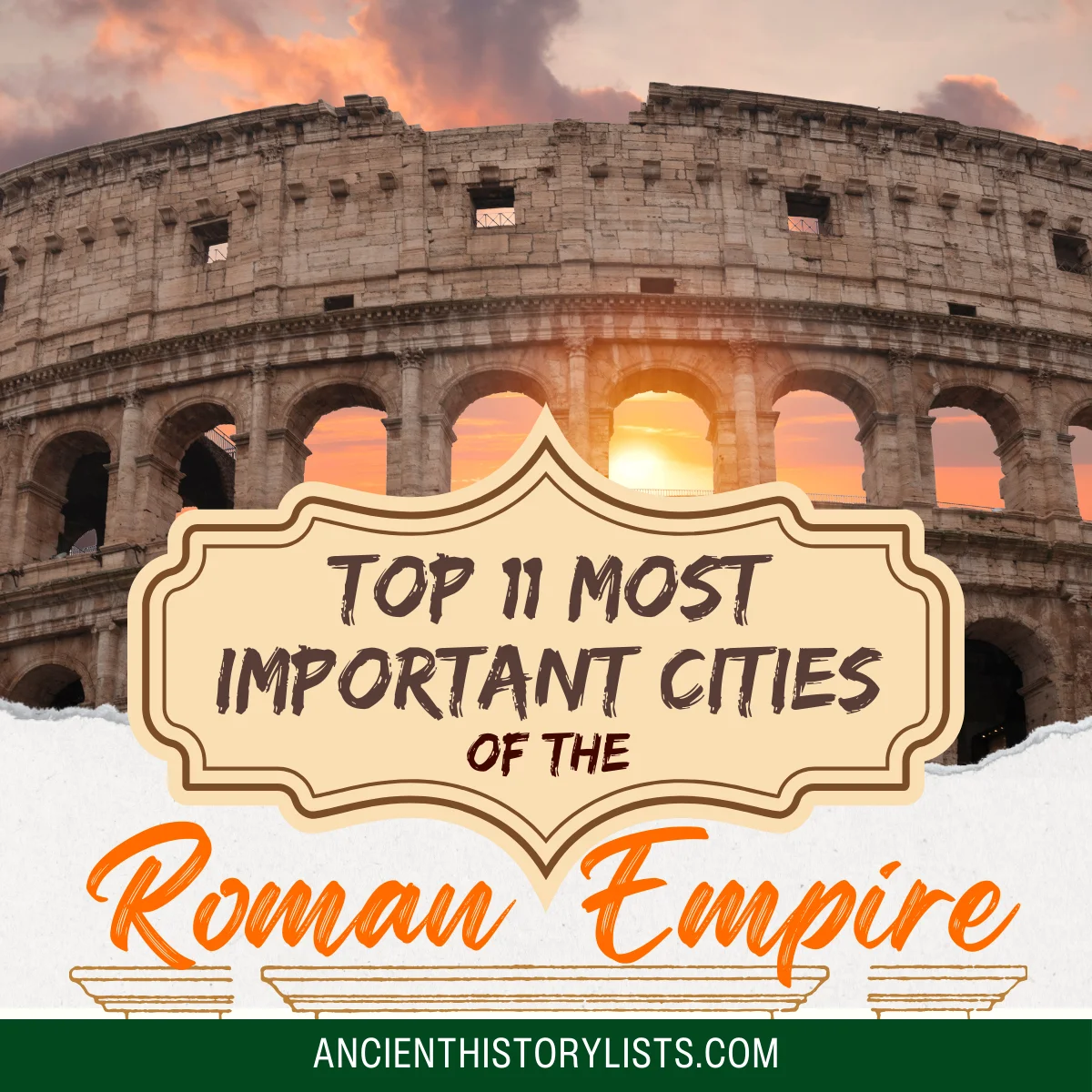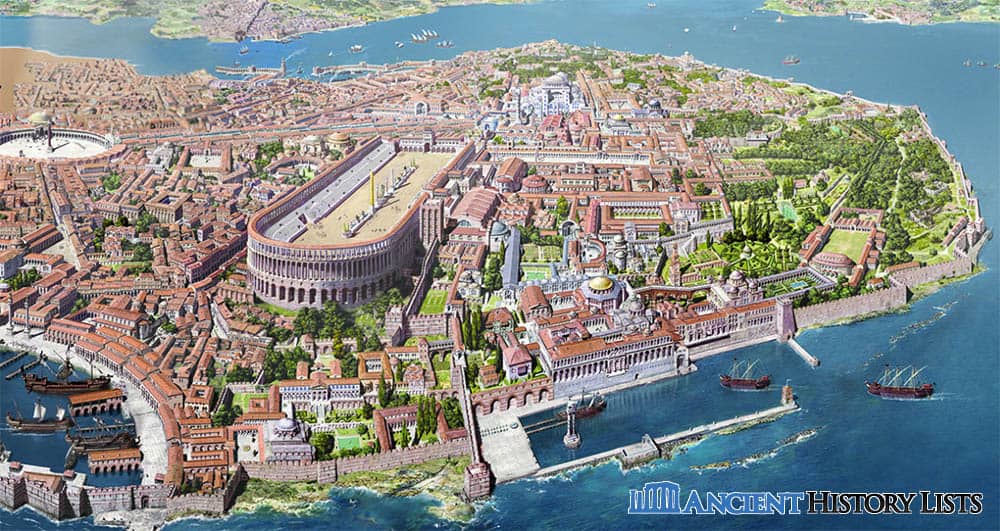The Latin expression imperium sine fine (“empire without end”) communicates the idea that neither time nor space could constrain the Roman Empire.
The Romans’ enthusiasm for creating and expanding their cities led to significant changes to their environment, such as extensive quarrying and deforestation to provide wood.
The Romans built many great cities throughout their empire, and these cities were all constructed along similar lines. The roads were straight and formed a grid pattern. At the center of the town were two long avenues running east to west and north to south. At the intersection of these two main roads were the administrative buildings, temples, markets, and meeting places.

The towns were surrounded by tall walls to help keep out invaders. These walls were particularly inportant for towns close to the edges of the realm. Canals brought fresh water into the cities to feed the wells and bathhouses. Cities on the coast were mainly concerned with business, while the ones inland were mainly administrative.
The Roman Empire conquered a lot of cities, and many of them were kept as the administrative centers of the original kingdoms such as Jerusalem, Alexandria, and Athens. Some were reconstructed such as Carthage and Sarmizegethusa Regia (Dacia). Jerusalem was completely destroyed after numerous Jewish rebellions against the empire. One exception was Constantinople, which was built from scratch on the site of the old city Byzantium.
Much of this Roman development occurred during the time of the republic. However, parts of northern Europe were conquered in the first century AD as Roman control in Europe, Africa, and Asia increased.
1. Constantinople

Constantinople became the new Roman capital city of the east. It was built on the site of the old Greek state of Byzantium on the shores of the Propontis in AD 330 by the then ruler Constantine. It was considered a new Rome and became known as the Queen of Cities.
It also acted as a gateway between the Mediterranean and the Euxine (Black) seas. It rapidly turned into a trading capital of the late Roman Empire, being on the western end of the spice and silk routes. For this reason, it soon became famous for its riches, indulgence, and extraordinary trading facilities.
The Holy See of Constantinople became the eastern equivalent of the Holy See of Rome in AD 451 at the Council of Chalcedon. Throughout its fascinating history, Constantinople was noted for the magnificence of its places of worship, especially the Hagia Sophia.
After the fall of the Western Roman Empire in AD 476, Constantinople became the capital of the Eastern Roman Empire and was looked upon as the new Roman capital as political power gradually moved eastwards. After the fall of the Western Empire, the emperor in Constantinople became the sole Roman emperor until 1453.
Later, during the medieval Byzantine Empire, and for a great part of the Middle Ages, Constantinople was the wealthiest and most densely populated city in Europe. Its walls, which were frequently described as “the tallest and most dominant on the planet,” would be breached just twice in a thousand years: once in 1204, and again in 1453. These are two dates which mark the end of Byzantine rule.
2. Antioch
Antioch, on the Orontes River, was the capital of both the Seleucid Empire and Roman Syria. It was an ancient city built by Seleucus I Nicator, a member of the Diadochi, who fought for succession of the Macedonian Empire after the death of Alexander the Great in 323 BC.
As the capital of the Seleucid Kingdom, Antioch flourished as a unique trading center as it was at the western end of the silk and spice road. Under Roman rule, it continued as a center for trade and, in the latter days of the empire, became a center for early Christianity.
It was seized by the Arabs during the invasions of the seventh century and was regularly challenged by both the Byzantine Empire and the Arab Caliphates all throughout the early medieval period.
It was recovered through the combined powers of the Byzantine Empire and the crusaders of the First Crusade in 1098 and was a first step and staging post for the recovery of the Holy Land. After the death of the Byzantine emperor Manuel I Komnenos in 1180, it was seized by the Seljuq Turks, and because of the destruction of the empire under Angeloi rule, it could never again be recovered by the Romaioi.
3. Ravenna
In its early days, Ravenna was nothing more than a backwater consisting of a collection of shacks around various tidal lakes surrounded by dense bogland. The Romans actually overlooked it as they swept through the Po River area, yet it was later added to the republic as a kind of afterthought.
Augustus built a military port in Ravenna which hastened its development and flagged it up as a town of some significance. Trajan eventually built a system of canals around Ravenna, yet its significance was only properly cemented when Emperor Honorius moved the capital of Western Rome there.
Ironically, the move was prompted by the exact reason the Romans had overlooked it hundreds of years before: the marshes. The muddy and inhospitable position of Ravenna made it a lot easier to protect against insurgents.
4. Ephesus
Ephesus was an old Greek city which was built in the 10th century by Greek colonists. It was situated three kilometers southwest of present-day Selçuk which is near Izmir, Turkey.
During the time of the Roman Empire, Ephesus existed as a focal point for business and transport as it had a well-established seaport joining the east to the west. The famous Temple of Artemis was located at Ephesus, and today the temple is included in the Seven Wonders of the World.
The Ephesians also feature in the Bible (Acts 19:23–41) as they are addressed by the apostle Paul. Paul was accused of offending the popular Artemis and her sanctuary.
5. Carthage
Carthage was established by the Phoenician queen Elissa in 814 BC. It gained freedom in 650 BC. The city acted as a trading hub for the western Mediterranean, but despite its prosperity, Carthage also needed to manage threats to its autonomy.
The city was not on friendly terms with the Berbers, the Greeks in Sicily, or the Roman Republic. These tensions eventually led to the Punic Wars (264 BC–146 BC). Towards the end of the Punic Wars, Roman troops completely devastated Carthage, the city became a Roman settlement, and the Carthaginians found themselves under Roman rule. Today, Carthage lies in ruins after Byzantine forces decimated it in 698 AD.
6. Alexandria

The city of Alexandria was established by Alexander the Great in 33 BC. The town developed so quickly that it soon overtook other big cities such as Carthage.
A hundred years after its establishment, it had become one of the world’s biggest cities in terms of importance and population size; it was home to a large Greek and Jewish population.
It was also an important city for education, and the Greek translation of the Bible, the Septuagint, was done in Alexandria. The city fell to the Romans in 30 BC, becoming a center for development in the ancient world and attracting many philosophers, logicians, researchers, and mathematicians.
7. Amorium
Amorium assumed an unmistakable position after the fall of Egypt and Syria to the Arabs. It was instrumental in blocking the Arabs from entering the Anatolian plateau. It was also the birthplace for a line of sovereigns and found itself at the center of a row over iconoclasm.
Amorium was the capital of Anatolikon, an important military area for the Eastern Empire. Its importance was shortlived due to a Byzantine attack led by the Caliph Abd ar-Rahman ibn Khalid who marched on the emperor’s main residence of Amorium. He even instructed his troops to paint the word “Amorium” on their shields and flags to make his intentions clear. He effectively sacked the city, and while it remained a useful hub, it never truly recovered its significance. The sacking of the city led to the idea that God’s support in war could not be guaranteed by the use of icons.
8. Athens
Athens was an important social focus during the late Republic and the Principate. It became a center for the education of young, wealthy Roman men. Athens’ significance faded over time until eventually it fell under attack by the city-state Sparta.
9. Milan
For a while, Milan was the acting capital of the Western Empire for several key reasons: it was near the outskirts of the empire which allowed the emperor greater control of the military; it allowed the emperor to focus his powers along the border with the so-called Gallic Empire; it was also the seat of St Ambrose who had great influence over the empire. St Ambrose even had the authority to contradict the emperor and challenge his power.
10. Thessalonika
Thessalonika came to prominence during the later stages of the empire, particularly after the fall of Rome. It was a unique community for business and trade, and it most likely had a population of around 150,000 to 200,000 during the 12th century, making it more significant than any city in Western Europe. Only Constantinople was bigger.
It was also profoundly important as a center for the religious education of the northern Slavic clans, and the saints Cyril and Methodius – who created the Glagolitic script which later became the Cyrillic script – also lived there. The city surrendered to the Venetians in order to protect it from the Turks. This, however, only worked for a short time.
11. Mystras
Mystras is a bit of an anomaly. During the fading days of the Eastern Empire, when all that was left was the area around Constantinople and Morea (the Peloponnese), Mystras became the second city. It experienced a remarkable cultural and social boom during the period when Constantinople began to fall, and shortly after, became a magnet for philosophers, scholars, and engineers. A noteworthy philosopher who worked in Mystras, Plethon, would eventually flee to Italy and help kickstart the Renaissance.